The Prehistory and History of Papua
Prehistory
The first people to inhabit New Guinea may have arrived as early as 42,000 to 60,000 years before present via Indonesia. These days, however, the migrations to this area of the world are still being debated and may change as new research is completed, especially in Australia. The most recent evidence shows that Homo sapiens have been living in Australia for at least 65,000 years and that humans have been living in the highlands of New Guinea for at least 50,000 years.
At the time of an early glacial period the sea levels in the area may have been as low as 150 meters below present levels. 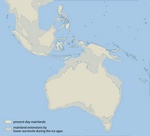 However, evidence is still scare. These early Papuans were most likely related to the aboriginal groups occupying the Malay-Indo archipelago and may have been related to Java Man going back to 1.5 million to 500,000 years BP.
However, evidence is still scare. These early Papuans were most likely related to the aboriginal groups occupying the Malay-Indo archipelago and may have been related to Java Man going back to 1.5 million to 500,000 years BP.
Although there is an argument that homo sapiens in Southeast Asia and Australia are a localized evolution of Homo erectus (Java man), there is no real evidence to support this. There are suggestions that Homo erectus may have been in Flores as early as 840,000 years ago. It seems more likely that Homo sapiens moved down from China sometime after 70,000 bp. But we need to remember that there is much work to be done in this area as shown by the discovery of Flores man the hobbit in 2003.
H. floresiensis has been nicknamed the 'Hobbit' species because of its small size. Scientists have found many near-whole skeletons of this species on the island. The theory of the diaspora of humans radiating away from their African homeland has been remolded and changed due to the discoveries of these newer forms of human ancestors. Homo floresiensis in particular exemplifies a divergent path from the original, linear idea of human evolution. 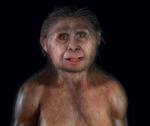 TWhile there is little certainty of the exact point of speciation, scientists postulate that this species evolved separately from other Homo erectus species because of their isolation on the island of Flores, although here too there is a considerable source of disagreement as to whether they were a separate species from Homo sapiens. Bone evidence suggests a date from 100,000 to 60,000 years ago with them dying out around 18,000 years ago. They may have evolved from Homo erectus. The Hobbit's height was about 1.1 meters. Stone tools have been found along with the bones. Some think that these finds do not belong in the homo genus. However, dentition suggests a relationship with Homo erectus and a dwarfism due to the environmental conditions on the island of Flores. Are the Flores samples microcephalic?
TWhile there is little certainty of the exact point of speciation, scientists postulate that this species evolved separately from other Homo erectus species because of their isolation on the island of Flores, although here too there is a considerable source of disagreement as to whether they were a separate species from Homo sapiens. Bone evidence suggests a date from 100,000 to 60,000 years ago with them dying out around 18,000 years ago. They may have evolved from Homo erectus. The Hobbit's height was about 1.1 meters. Stone tools have been found along with the bones. Some think that these finds do not belong in the homo genus. However, dentition suggests a relationship with Homo erectus and a dwarfism due to the environmental conditions on the island of Flores. Are the Flores samples microcephalic?
Scientists are still debating how the original people arrived on the island because it is many miles away from the nearest Asian mainland. While these people are thought to have used stone tools and perhaps fire, they are not believed to have built ships. Is there a connection with H. sapiens based on DNA - we don't know because so far we have no DNA. Did they have a language, did they travel on to other islands farther to the east? Lots of controversy and heated debate including some intense disagreements between the Australian researchers and the chief Indonesian researcher who took samples and later returned them damaged.
 And then there is "Homo denisova". In terms of migration, the story of "Homo denisova" is even more muddled. Scientists have used DNA analysis in order to try and determine the gene flow and therefore migration of the "Homo denisova" peoples. It is believed that these people migrated south from Russia towards South East Asia and met and bred with humans in their travels, creating a hybrid peoples. This information is based on the fact that many people of the South East Asian region share 5-6% of their DNA with Denisovan ancestors (Harmon 2012). It is believed that the people of mainland Asia do not contain the same amount of "H. denisova" DNA because subsequent waves of migrations hybridized the people and slowly replaced any trace of this DNA from the population. Specifically, "H. denisova" DNA is most prominently found in the people of Melanesia, New Guinea and South East Asia. The "H. denisova" population is said to have been small and contained little genetic diversity. This persistence of the "H. denisova" DNA suggests that these ancient ancestors aren't as removed from modern humans as might be assumed.
And then there is "Homo denisova". In terms of migration, the story of "Homo denisova" is even more muddled. Scientists have used DNA analysis in order to try and determine the gene flow and therefore migration of the "Homo denisova" peoples. It is believed that these people migrated south from Russia towards South East Asia and met and bred with humans in their travels, creating a hybrid peoples. This information is based on the fact that many people of the South East Asian region share 5-6% of their DNA with Denisovan ancestors (Harmon 2012). It is believed that the people of mainland Asia do not contain the same amount of "H. denisova" DNA because subsequent waves of migrations hybridized the people and slowly replaced any trace of this DNA from the population. Specifically, "H. denisova" DNA is most prominently found in the people of Melanesia, New Guinea and South East Asia. The "H. denisova" population is said to have been small and contained little genetic diversity. This persistence of the "H. denisova" DNA suggests that these ancient ancestors aren't as removed from modern humans as might be assumed.
This view, as expressed above, has been of the generally accepted versions of how early Homo sapiens arrived in Australia/Papua. However, a somewhat different explanation was just made public last year based on sophisticated techniques analyzing the DNA of Papuan/Aboriginal Australian populations. According to this view, Aboriginal Australians and Papuans diverged from Eurasians 51-72,000 years ago following a single out-of-Africa dispersal and subsequently mixed with archaic Neaderthals/Denisovans/? - and then diversified from each other sometime around 25-40,000 years ago.  The original Aboriginal Australian/Papuan population reached the area when it was still the continent known as Sahul, that is when there were still land connections between New Guinea, Australia and Tasmania. There is genetic evidence that as the original population split, the Papuan ancestors also diverged and spread out through Papua along the coasts, into the interior and up to the islands in the north - Raja Ampat, Biak, etc.
The original Aboriginal Australian/Papuan population reached the area when it was still the continent known as Sahul, that is when there were still land connections between New Guinea, Australia and Tasmania. There is genetic evidence that as the original population split, the Papuan ancestors also diverged and spread out through Papua along the coasts, into the interior and up to the islands in the north - Raja Ampat, Biak, etc.
Sounds confusing enough. I took my last physical anthropology course in 1979. A few years ago I began taking physical anthropology courses online through Coursera and EdX and found the remarkable discoveries over that 30 plus year period. These continue to happen and as scientists should be theories about human evolution continue to be refined and modified to fit new data. What seems clear getting back to our main area - Papua - is that Homo sapiens or a different species perhaps yet unknown were here possibly as long as 48,000 years ago and developed their phenotypes in response to environmental conditions.
Historical Period
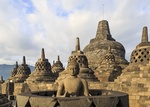 Up later in history. There is evidence that the Sriwijaya (centered on Sumatra from 7th to 14th century) and Majapahit (centered in Java from 13th to 16th century) kingdoms did some trading with coastal populations in Papua and may have taken slaves as well. After the Portuguese captured Malacca, they begin sending expeditions out east to find the legendary spice.
Up later in history. There is evidence that the Sriwijaya (centered on Sumatra from 7th to 14th century) and Majapahit (centered in Java from 13th to 16th century) kingdoms did some trading with coastal populations in Papua and may have taken slaves as well. After the Portuguese captured Malacca, they begin sending expeditions out east to find the legendary spice.
In 1526 deMeneses arrived at Waigeo Island by accident (he was blown of course on his way to Ternate). He named the island Ilhas dos Papuas meaning roughly the island of the frizzy haired. In 1528, the conquistador, Hernan Cortez, sent Alvaro de Saavreda out to search for the "island of gold." He was also to relieve the Spanish outpost on Tidore which was under siege by the Portuguese. He spent a month there with the "naked black people" and made plans to return but never did. Cortez again sent another ship out to find the island of gold, but this voyage was a disaster when the crew mutinied and killed the captain. The ship was abandoned in Cenderawasih Bay. Seven survivors were captured and made slaves by the local population. As I mentioned earlier, Ortiz de Retez sailed along the northern coast and claimed Papua for the Spanish Crown and gave it the name Nueva Guinea. Despite claiming the land for Spain, they never proved to be a player in the colonial games involving Papua.
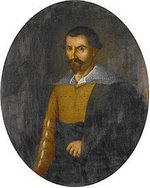 No gold was found and the Spanish essentially gave up although they kept claim to New Guinea only later to give up the claim under the treaty of Utrecht in 1714 to the Dutch and English. In 1623, the Dutch explorer Jan Carstensz reported that he sighted snowcapped mountains but no one believed him.
No gold was found and the Spanish essentially gave up although they kept claim to New Guinea only later to give up the claim under the treaty of Utrecht in 1714 to the Dutch and English. In 1623, the Dutch explorer Jan Carstensz reported that he sighted snowcapped mountains but no one believed him.
The Dutch effectively made a claim on Papua due to their colonial relationship with the Sultanate of Tidore. But again, outposts were never made and the Dutch interest in the islands was limited to trading with coastal populations. So Papua had no spices and no gold (none that was apparent), so it lost much of its interests to the Europeans. But it remained a place with valuable trade goods for the Javanese, Bugis, Bandanese and Seramese.
Valuable trade items included massoi bark - valued for its ability to cure a number of illnesses including venereal disease - nutmeg (low grade nutmeg), trepang (dried sea cucumbers, tortoise shells, pearls, bird of paradise skins and slaves.
 The French explorer Bougainville was here in 1768, Captain Cook was here in 1770 and was chased off by natives with an exploding white powder. Thomas Forrest showed up in 1774 on orders from the British East India Company looking for spices in places not controlled by the Dutch. Forrest spoke Malay fluently, had excellent relationship with the locals partly because of that and he was also known for his antics with a flute that he took everywhere with him which led to his name among the residents of Raja Ampat of the Mad Captain. Forrest noted in a book that he wrote about his voyages that the residents of the small island in Raja Ampat were of two types: Malays who he called Moors of copper color with long hair and mopheaded Papuas.
The French explorer Bougainville was here in 1768, Captain Cook was here in 1770 and was chased off by natives with an exploding white powder. Thomas Forrest showed up in 1774 on orders from the British East India Company looking for spices in places not controlled by the Dutch. Forrest spoke Malay fluently, had excellent relationship with the locals partly because of that and he was also known for his antics with a flute that he took everywhere with him which led to his name among the residents of Raja Ampat of the Mad Captain. Forrest noted in a book that he wrote about his voyages that the residents of the small island in Raja Ampat were of two types: Malays who he called Moors of copper color with long hair and mopheaded Papuas.
The British made several attempts at settling on the island, but they all failed and by 1824 they agreed with the Dutch that Papua would be part of the Dutch East Indies. German missionaries were active on the island beginning in the mid-1800s. But the Dutch really didn't do much in terms of development.
 Just one more explorer/scientist/adventurer who has journey into the Papua region. For me, one of the most important of all these men and that is Alfred Russel Wallace. Wallace was one of those 19th century British men whose knowledge covered a wide range of topics including anthropology, geography, biology, zoology, political philosophy. He was an adventurer and a scientist. But, unlike many of his contemporaries, he did field work. He was not what we anthropologists call an armchair anthropologist. His field work ranged from the Amazon to the Malay Archipelago. He's known for having independently of Darwin come up with the theory of evolution via natural selection and for coming up with the Wallace Line that divides Indonesia into two spheres: one where the animals are of primarily Asian origin and the eastern area of Indonesia where the animals are of Australasian origin.
Just one more explorer/scientist/adventurer who has journey into the Papua region. For me, one of the most important of all these men and that is Alfred Russel Wallace. Wallace was one of those 19th century British men whose knowledge covered a wide range of topics including anthropology, geography, biology, zoology, political philosophy. He was an adventurer and a scientist. But, unlike many of his contemporaries, he did field work. He was not what we anthropologists call an armchair anthropologist. His field work ranged from the Amazon to the Malay Archipelago. He's known for having independently of Darwin come up with the theory of evolution via natural selection and for coming up with the Wallace Line that divides Indonesia into two spheres: one where the animals are of primarily Asian origin and the eastern area of Indonesia where the animals are of Australasian origin.
Wallace also developed several other important biological concepts and was an early environmentalist as well. He wrote extensively on a variety of subjects. He traveled through the Malay Archipelago from 1854-1862. he was in his early 30s then. He was not from a family of means so he supported his studies by selling his collections of plants and animals as he worked. He set off from Ternate in March 1858 and ended up in Dorey (the present-day Manekowari) where he spent three months and then moved on to Waigeo where he spent another three months. Upon his arrival he met a pair of German missionaries who were he noted of lower class so as better to relate to the local natives. 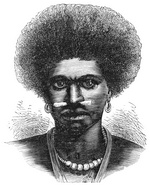 Upon first entering a house in the village of Dorey, Wallace notes that there were human skulls under the eves of many houses which were trophies of their battles with Arfaks, a tribe from the interior who often raided these coastal villages. He also comments on a large boat shaped council house supported by large posts that were carved to represent two naked figures a man and a woman as well as other "more revolting" carvings. Wallace injured himself quite severely while out hunting insects and was confined to be for over a month. He notes that during this time he was driven to distraction by seeing marvelous butterflies fly past his door. After three months Wallace moved on and commented that he was not unhappy to be leaving as he had not found most of what he was looking for including the bird of paradise, but he did find an abundant supply of ants. On Waigeo, Wallace finally found his bird of paradise.
Upon first entering a house in the village of Dorey, Wallace notes that there were human skulls under the eves of many houses which were trophies of their battles with Arfaks, a tribe from the interior who often raided these coastal villages. He also comments on a large boat shaped council house supported by large posts that were carved to represent two naked figures a man and a woman as well as other "more revolting" carvings. Wallace injured himself quite severely while out hunting insects and was confined to be for over a month. He notes that during this time he was driven to distraction by seeing marvelous butterflies fly past his door. After three months Wallace moved on and commented that he was not unhappy to be leaving as he had not found most of what he was looking for including the bird of paradise, but he did find an abundant supply of ants. On Waigeo, Wallace finally found his bird of paradise.
Papua became important for the West during WWII. The Japanese occupied what is now Jayapura as well as a number of surrounding islands and most especially the island of Biak and as far south as Timika.
So, we have an overview of the prehistory/history of Papua. We need to remember that Papua has been pretty much been left alone except for trading along the coast. 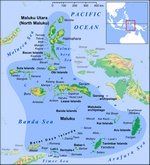 It only came into the view of Europeans over the last 500 years mostly due to the interest in the Spice Islands. But the interior regions and the smaller remote islands like Raja Ampat just didn't have much interest to early Europeans other than as a place to pass through as part of the Spice Route.
It only came into the view of Europeans over the last 500 years mostly due to the interest in the Spice Islands. But the interior regions and the smaller remote islands like Raja Ampat just didn't have much interest to early Europeans other than as a place to pass through as part of the Spice Route.
After my first year in Papua, I returned to the University of California, Berkeley and dug through the storage areas in the basement of the Lowie Museum of Anthropology and was surprised, and somewhat delighted, to find that many of the artifacts that I was collecting - bows and arrows, spears, net bags, penis gourds, digging sticks, stone axes, Asmat carvings - were basically the same as those in the basement that dated back to the early part of the 20th Century. Not much change. Not much development. This shows just how isolated the local populations were. Until it was realized that there was plenty of gold and copper in the interior that could be exploited. And then things began to change.
Here's a short clip that looks at some of the changes happening because of the gold and copper/ We see in the clip the impact that the Freeport mine has on the Amungme, the local tribe but the story goes deeper than that. Because these kinds of things - modernization and globalization - don't just affect, in an area like Papua, one tribe, the effects ripple throughout the island, throughout all the cultures to one degree or another. The Dani, the Asmat and the Kamoro - three other tribes that we will be looking at - have also been impacted by the Freeport mine and will continue to be impacted.
Migrations go on to the mine site, people looking for jobs or some cargo of one type or another. These migrations create tension. 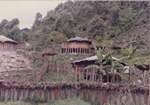 The newcomers take up the traditional lands of the Amungme, they compete for limited resources, cultures that are similar are still different and there are going to be conflicts. And it wasn't that long ago, that warfare was the way that differences were settled. Those battles are still going on. After thousands of years of an island of unique cultures staying relatively static. A tsunami hits them and suddenly there are clothes and helicopters and towering trucks running through their sacred land, disturbing their spirits, scaring away their animals, polluting their rivers. They gaze through fences surrounding a city built in the clouds that is full of cars, washing machines, televisions, electricity, modern medicine and their world is shaken. So far no real cargo cults have developed but they're fighting back, organizing, trying to make sense of this new world. It's a story that deserves to be watched.
The newcomers take up the traditional lands of the Amungme, they compete for limited resources, cultures that are similar are still different and there are going to be conflicts. And it wasn't that long ago, that warfare was the way that differences were settled. Those battles are still going on. After thousands of years of an island of unique cultures staying relatively static. A tsunami hits them and suddenly there are clothes and helicopters and towering trucks running through their sacred land, disturbing their spirits, scaring away their animals, polluting their rivers. They gaze through fences surrounding a city built in the clouds that is full of cars, washing machines, televisions, electricity, modern medicine and their world is shaken. So far no real cargo cults have developed but they're fighting back, organizing, trying to make sense of this new world. It's a story that deserves to be watched.
Coming soon: The Ethnic Groups of Papua

